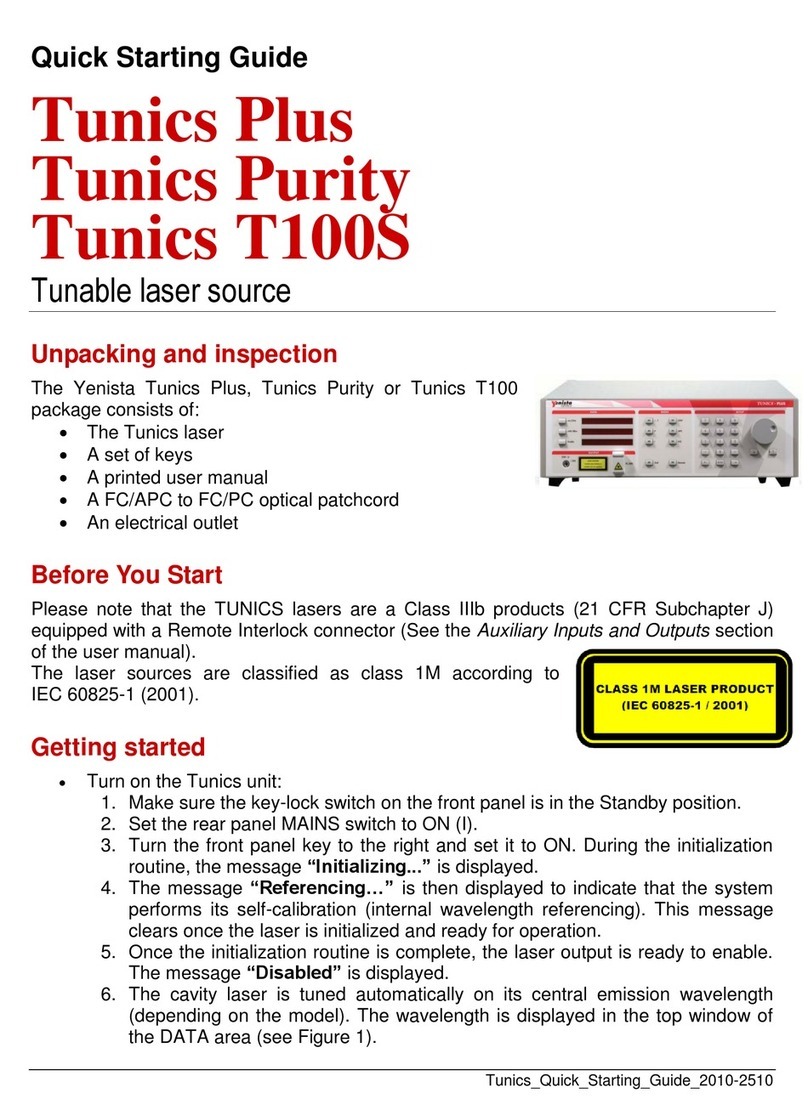
TUNICS T100S-HP User Manual 3
Legal Notice
Copyright
Copyright © 2013–2016 by Yenista Optics. Published by Yenista Optics. All rights reserved.
This documentation is provided as a user manual to Yenista Optics’ customers and potential customers only.
The contents of this document may not be reproduced in any part or as a whole, transcribed, stored in a
retrieval system, translated into any language, or transmitted in any form or by any means (electronic,
mechanical, magnetic, optical, chemical, photocopying, manual, or otherwise) without the prior written
permission of Yenista Optics.
Trademarks
"Yenista Optics", "Yenista" and "TUNICS" are registered trademarks of Yenista Optics. Other trademarks
mentioned in this publication are used for identification purposes only.
Product Warranty and Limitation of Warranty
This Yenista Optics instrument product is warranted against defects in material and workmanship for a period
of one year from date of shipment. During the warranty period, Yenista will repair products that prove to be
defective. For warranty service or repair, such product must be returned to Yenista. Please contact Yenista
support services for the appropriate procedure. Yenista does not accept any equipment shipped back without
following the procedure.
Yenista Optics warrants that its software and firmware designated by Yenista for use with an instrument will
execute its programming instructions when properly installed on that instrument. Yenista does not warrant
that the operation of the instrument, software, or firmware will be uninterrupted or error-free.
The foregoing warranty shall not apply to defects resulting from improper or inadequate maintenance by
Buyer, Buyer-supplied software or interfacing, unauthorized modification or misuse, operation outside of the
environmental specifications for the product, or improper site preparation or maintenance.
Disclaimers
No Warranties: This documentation is provided "as is" without any ex-touch or implied warranty of any kind.
Limitation of Liability: Yenista Optics does not assume any liability arising out of the application or use of any
products, or software described herein. In no event shall Yenista Optics or its affiliate companies be liable for
any damages whatsoever (including, without limitation, consequential or incidental damages, damages for
loss of profits, or otherwise) arising out of the use of the information provided in this documentation.
The contents of this publication have been carefully checked for accuracy. However, Yenista Optics makes no
warranty as to the completeness, correctness, or accuracy of the information contained within this
documentation. In the interest of continued product improvement, Yenista Optics further reserves the right to
make changes to any products described herein without notice. This publication is subject to change without
notice.
US Patents
The proprietary configuration of TUNICS T100S-HP is patented under US patents # 5,594,744, #5,802,085,
#6,252,718 B1, #6,324,193 B1, #6,339,609 B2 and #6,519,269 B1. These patents are fully owned by YENISTA
OPTICS S.A.




























